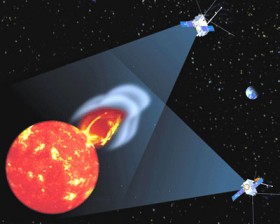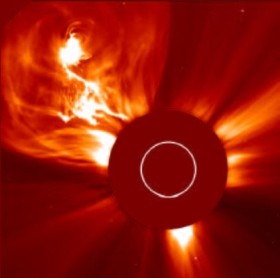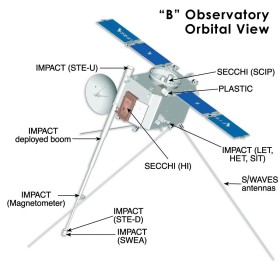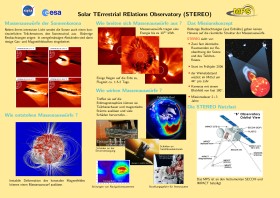STEREO: A New Dimension in Solar Research
The launch of the NASA STEREO mission is soon ahead, MPS involved
On September 18 2006 NASA plans to launch two space probes in Cape Canaveral which will initiate a new area in solar research.
The two almost identical space probes constitute NASA's  STEREO mission. With support also from ESA, the probes have been developed and built in the Labs of the world's leading research institutes in solar science during the recent 7 years. In Germany, the Max Planck Institute for Solar System Science (MPS) in Katlenburg-Lindau is a key member in this science consortium. In collaboration with the Universities in Kiel and Göttingen, the MPS has contributes important parts for the probes' telescopes and particle detectors.
STEREO mission. With support also from ESA, the probes have been developed and built in the Labs of the world's leading research institutes in solar science during the recent 7 years. In Germany, the Max Planck Institute for Solar System Science (MPS) in Katlenburg-Lindau is a key member in this science consortium. In collaboration with the Universities in Kiel and Göttingen, the MPS has contributes important parts for the probes' telescopes and particle detectors.

|
|
Figure 1: Sketch of the two STEREO probes in relation to Earth (middle right) and Sun (lower left with eruption)
|
The launch window starts on September 18. The launch vehicle is a Delta II rocket.
The name of the mission, STEREO, is an acronym for "Solar TErrestrial RElations Observatory" which reveals the goals of this mission: A better understanding of processes on the solar surface and their impact on the Earth's atmosphere; in short: improve our understanding of "space weather". For the first time, scientists will be able to look at the Sun through the telescopes of the two independent probes from two distant vantage points in space. The field of view will comprise the Sun, its atmosphere, the corona, and the heliosphere out to the Earth's orbit. The observations will for the first time allow a three dimensional analysis of solar eruptions and coronal mass ejections, their magnetic fields and the cosmic ray showers they cause.
Mankind has experienced the Sun's ambiguous role for life on Earth ever since. Today we can describe the Sun's benefits and dangers to some detail: Sunlight causes the right temperature range which makes life possible on the Earth's surface. However, the Sun also emits UV, X-ray and particle radiation which if it penetrates the Earth's atmosphere is a sever threat to any form of life.
Since the existence of solar wind was predicted by the German astrophysicist Ludwig Biermann about 50 years ago and it was investigated by a number of space missions, among them one of the few German national space missions  HELIOS. What came as a surprise in these observations were sudden and intensive perturbations embedded in the otherwise continuous billion km/h fast stream of mainly protons and Helium ions.
HELIOS. What came as a surprise in these observations were sudden and intensive perturbations embedded in the otherwise continuous billion km/h fast stream of mainly protons and Helium ions.
They were found to originate from eruptions and mass ejections on the solar surface (Fig. 2) In these mass ejections up to 10^10 tons (about the mass of Ben Nevis, Scotland) are accelerated into space and dash away from the Sun while confined by a magnetic field.

|
|
Figure 2: A mass ejection observed with the LASCO coronagraph onboard SOHO. The Sun is hidden behind the occulter in the lower right. Its size and location is indicated by the white circle.
|
If such a huge clouds happen to approach the Earth, they constitute an additional risk. The outermost boundary of the Earth's atmosphere, the magnetopause, usually at a distance 10-15 Earth radii form the Earth's surface, may be pushed down to only half this distance under the pressure of the cloud. A visible consequence of such an event is an increased auroral activity even at medium geographical latitudes. Particles are energized during the eruption and also on the front side of the mass ejection cloud up to a million kilovolts which may deeply penetrate into the Earth's atmosphere. Astronauts in space are then for hours exposed to an enhanced level of radiation, space satellites may charge up as a consequence of the particle bombardment and their electronics may be destroyed.
In the past, eruptions and mass ejections have only been observed from nearby the Earth. We therefore know that they occur with varying frequency: during the 11 year solar cycle these events happen about once a fortnight at times of minimum solar activity while at maximum activity several of them may occur in the course of a day. A shortcoming of these past observations was that they were heavily biased towards mass ejections occurring on the visible solar limb. These ejections are less dangerous for Earth because they propagate approximately sideways from the Sun-Earth line. Those ejections which were directed towards Earth could hardly be discerned against the bright solar background. This is where the STEREO mission will bring about an essential improvement.
The two 620 kg space probes each are sized 6.4 m x 4.3 m x 2.6 m. About 2-3 months after launch gravity assist by the moon will be employed to redirect their momentum to an orbit around the Sun similar to Earth's orbit. However, the orbital periods of the two probes will slightly deviate from the 1-year period of the Earth: one probe will be a bit faster, the other slower than Earth. As seen from the Sun they will gently increase their distance from Earth by about 20 degrees/year. With increasing distance the space probes offer unique views on the Sun and the surrounding heliosphere from two different view directions as indicated in Fig. 1.

|
|
Figure 3: One of the probes showing its instrumentation: the telescopes (Experiment SECCHI/SCIP), the wide-angle camera (SECCHI/HI), the particle sensors (IMPACT und PLASTIC) and the radio wave experiment (SWAVES). The Sun's direction is towards the top, the antenna dish points towards Earth.
|
Both probes are equipped with several telescopes with fields of view out to 1 AU. The data expected from these instruments allows for the first time a three dimensional reconstruction of structures on the Sun's surface, in the corona and beyond. For the first time we will be capable to make reliable predictions about the direction and speed of mass ejections. In particular we will be able to prognose with some certainty whether the gas cloud of a mass ejection will hit Earth. During the two-day travel time of the cloud to the Earth, there is time to take measures to protect astronauts and satellites. Other instruments on board the STEREO probes measure the energetic particles that run ahead of the mass ejection cloud and radio emissions generated by the enhanced occurrence of these particles. Fig. 3 gives an overview of the STEREO instrumentation.

|
|
Figure 4: Poster STEREO Project (only in German)
|
The mission is planned for initially 2 years. It will take much longer for the scientists at the MPS and other collaborating institutes in USA, Europe and Japan to analyse the wealth of data from the two probes. For the reconstruction, we will apply methods of stereoscopy and tomography. In the end we will have learnt to make better forecasts of space weather and predict with more precision the impact solar eruptions and mass ejections will have on our atmosphere.
Links
 STEREO at MPS
STEREO at MPS
 STEREO at NASA
STEREO at NASA
 STEREO at JHU/APL
STEREO at JHU/APL
 HELIOS at MPS
HELIOS at MPS
